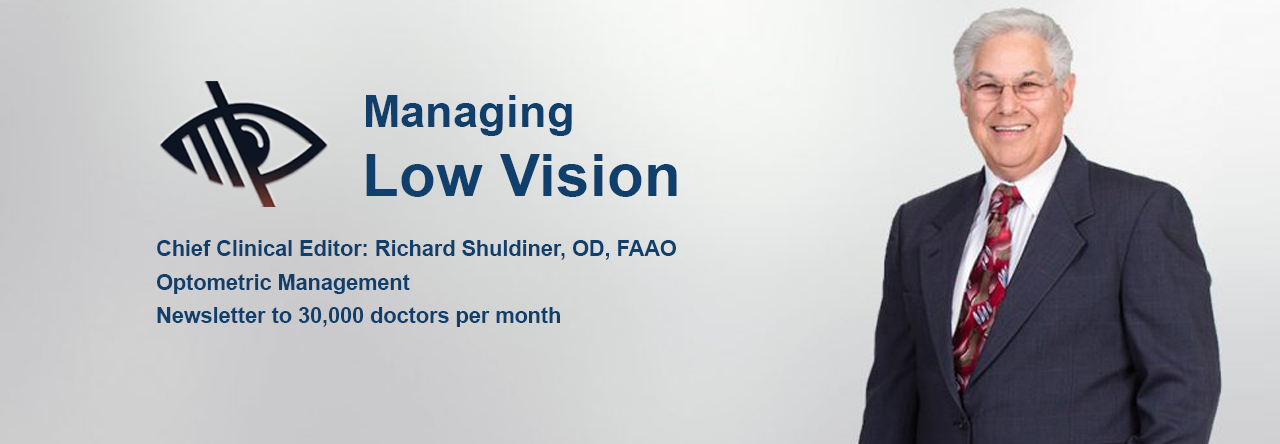May 2020
By Errol Rummel OD, FAAO, FCOVD, FNORA, FIALVS, with Richard J. Shuldiner, OD, FAAO, FIALVS, Chief Clinical Editor
NO, the title is not a “typo”. I really do practice “Slow Vision Care”!
Although “Slow Vision Care” is a negative term used by some of my colleagues when describing my chosen low vision care field of interest, I actually see the term “slow vision care” as a compliment. Clinical low vision care needs to be provided slowly and carefully to insure the best possible visual outcome.
The practice of “slow vision care” is the opposite of the “fast vision care” necessitated by the economics of low paying optical plans and medical insurance companies who claim we must examine people “more efficiently”. What they are actually saying is that we must examine more people per hour. The visually impaired do best with slow vision care.
Most people who are diagnosed with vision loss conditions, like AMD, are elderly and are told “nothing more can be done”. As soon as they hear this, they stop paying attention as the shock takes over. They do not realize that what you mean is that medicine, surgery, injections, or regular glasses are no longer going to improve the person’s eyesight. Once a visually impaired person hears those words, he/she is unable to process anything else that is said.
Hopefully, you were also going to say, “you should investigate doctors specializing in low vision who may be able to help you”. Please include a written note or brochure. Having them leave with a brochure on low vision, for example, would reinforce the recommendation that seeking consultation with a practitioner skilled in low vision may be helpful. Patients are invariably relieved when told there still is hope for vision improvement through low vision care.
It is common for the grown children and friends of the low vision patient to fail to believe or understand that their elderly family member sees poorly. After all, they think the person’s eyes look physically “normal” and the person seems to see acceptably well at near with a large print book. Yet the person still claims very blurry vision when viewing across the room and has difficulty trying to discern a face well enough to be able to recognize a friend they have known for years. Explaining those issues to the family or friends in front of the patient, during the low vision exam, helps validate the patient’s self esteem regarding their visual complaints.
For me, “slow” low vision care begins with a telephone consultation to determine the patient’s visual needs and wants, and to determine their cognitive level. I learn of the activities of daily living which are a visual issue for them. Do they want to be able to see the television better, or to be able to see the signs down the road when driving? Do they want to be able to read hard copy, or to see their computer screen better? If they have specific visual complaints, like reading a newspaper, or reading a novel, or being able to see their bills and postal mail, I need to know that in advance. Near testing with a near point eye chart requires a different type of looking than the actual newspaper or magazine they want to read. They are told to bring samples of the things they wish to read to the low vision exam to allow my evaluation to be realistic to their visual needs.
When they come into the office, the visually impaired deserve a slow and personal conversational welcome. It allows them to become more comfortable and attentive during the exam. Many of those with poor eyesight are depressed, and depression often appears during the exam with the person seeming uncooperative and/or angry. Slow low vision exams start with establishing a warm psychological connection with the patient.
In directing a neuro-optometric rehabilitation hospital clinic for the past 30 years, I have detected some neuro-visual issues that can only be determined during a careful, slow, low vision exam and can be missed by a quick evaluation. For example, a pseudo-ptosis, where the patient habitually keeps one eye closed to eliminate the diplopia of a binocular vision dysfunction. The closed eye may be interpreted by the examining doctor as a true ptosis.
By prescribing a prism for the diplopia, the need to maintain the closed eye “ptosis” dissolves as the patient experiences single vision. As another example, I performed a low vision exam on a monocular patient referred for very low vision in the remaining eye. However, it was determined by a binocular assessment that the remaining eye had a paralytic exotropia, and the vision was never tested along the line of sight of the exotropic eye.
By teaching the patient to turn the head in order to view along the line of sight, the visual acuity improved. Additionally, a slow low vision exam will increase awareness of a patient who has experienced a stroke, for example, and is complaining about poor vision. However, the complaint is actually related to the stroke induced hemianopsia which required special field expanding lenses and not traditional low vision glasses.
Slowly and carefully prescribing the most appropriate low vision glasses or other sight-improving device to a patient, and then slowly and carefully teaching the patient to successfully use the low vision prescription is crucial to success. Your patients deserve “Slow Vision Care”.

